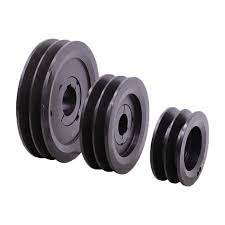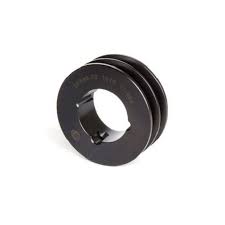Product Description
Taper Bore V-Belt Pulley
1.Material:Cast iron
2.Process: sand mold casting,machining
3.Bore: pilot bore, finished bore, taper bore, bore for QD bushing
4.Surface finish: black oxide,paint, phosphating
European standard:
a) V-belt pulleys for taper bushings: SPA, SPB, SPC,SPZ,groove up to 10
b) Adjustable speed V-belt pulleys and variable speed pulleys
c) Flat belt pulleys and conveyor belt pulleys
American standard:
a) Sheaves for taper bushings: 3V, 5V, 8V
b) Sheaves for QD bushings: 3V, 5V, 8V
c) Sheaves for split taper bushings: 3V, 5V, 8V
|
Belt Dimensions |
|||
|
|
m |
s |
n |
|
SPZ |
9.7 |
8.0 |
8.5 |
|
SPA |
12.7 |
10.0 |
11.0 |
|
SPB |
16.3 |
13.0 |
14.0 |
|
SPC |
22.0 |
18.0 |
19.0 |
|
Pulley Dimensions |
|||||||||
|
|
a |
b |
c |
d |
e |
f |
h |
34° |
38° |
|
SPZ |
9.7 |
8.5 |
8.0 |
12 |
8.0 |
2.5 |
12 |
p≤80 |
p≥80 |
|
SPA |
12.7 |
11 |
10.0 |
15 |
10.0 |
3.5 |
15 |
p≤118 |
p≥118 |
|
SPB |
16.3 |
14 |
12.5 |
19 |
12.5 |
4.0 |
18 |
p≤190 |
p≥190 |
|
SPC |
22.0 |
19 |
16.0 |
25 |
16.0 |
24 |
24 |
p≤315 |
p≥315 |
|
|
|
|
|
|
|
|
|
|
|
Essential details
Warranty:
1 year
Applicable Industries:
Building Material Shops, Manufacturing Plant, Machinery Repair Shops, Construction works , Energy & Mining
Customized support:
OEM, ODM
Place of Origin:
ZHangZhoug, China
Brand Name:
Kilomega
Product name:
Chinese black belt conveyor drive timing drum steel v belt pulley
Application:
Industry Machinery
Material:
Cast Iron
Color:
Black
OEM:
Avilable
Product Keywords:
v belt pulley
BRAND:
Kilomega
Type:
Standard
|
Belt Dimensions |
|||
|
|
m |
s |
n |
|
SPZ |
9.7 |
8.0 |
8.5 |
|
SPA |
12.7 |
10.0 |
11.0 |
|
SPB |
16.3 |
13.0 |
14.0 |
|
SPC |
22.0 |
18.0 |
19.0 |
|
Pulley Dimensions |
|||||||||
|
|
a |
b |
c |
d |
e |
f |
h |
34° |
38° |
|
SPZ |
9.7 |
8.5 |
8.0 |
12 |
8.0 |
2.5 |
12 |
p≤80 |
p≥80 |
|
SPA |
12.7 |
11 |
10.0 |
15 |
10.0 |
3.5 |
15 |
p≤118 |
p≥118 |
|
SPB |
16.3 |
14 |
12.5 |
19 |
12.5 |
4.0 |
18 |
p≤190 |
p≥190 |
|
SPC |
22.0 |
19 |
16.0 |
25 |
16.0 |
24 |
24 |
p≤315 |
p≥315 |
|
|
|
|
|
|
|
|
|
|
|
|
Shipping Cost:
Estimated freight per unit. |
To be negotiated |
|---|
| Certification: | CE, ISO |
|---|---|
| Pulley Sizes: | Type B |
| Manufacturing Process: | Casting |
| Samples: |
US$ 1/Piece
1 Piece(Min.Order) | Order Sample |
|---|
| Customization: |
Available
| Customized Request |
|---|

Can spa pulleys be replaced or repaired as part of spa maintenance?
Yes, spa pulleys can be replaced or repaired as part of spa maintenance. Here’s a detailed explanation of the options available:
1. Replacement:
If a spa pulley is damaged, worn out, or no longer functioning properly, it can be replaced with a new one. Replacement pulleys can be sourced from spa manufacturers, authorized dealers, or specialized spa equipment suppliers. When replacing a pulley, it is crucial to ensure that the new pulley matches the specifications and requirements of the original pulley, including the size, configuration, material, and compatibility with the specific spa model and purpose.
2. Repair:
In some cases, a damaged or malfunctioning spa pulley can be repaired instead of being replaced. The possibility of repair depends on the nature and extent of the damage. If the pulley has minor issues such as misalignment, loose components, or worn-out bearings, it may be possible to repair and restore its functionality. Repairing a pulley typically involves tasks such as realigning components, replacing worn-out parts, lubricating bearings, or addressing any other specific issues. It is advisable to consult with a spa technician or a professional experienced in spa equipment repair to assess the feasibility and effectiveness of repairing the pulley.
3. Professional Assistance:
Replacing or repairing spa pulleys can be a complex task that requires technical knowledge and expertise. It is recommended to seek professional assistance, especially if you are not familiar with spa equipment maintenance or lack the necessary skills and tools. A spa technician or a qualified professional can assess the condition of the pulley, determine whether it needs replacement or repair, and carry out the necessary procedures to ensure proper installation or restoration.
4. Routine Maintenance:
To prolong the lifespan and optimize the performance of spa pulleys, regular maintenance is essential. This includes tasks such as cleaning the pulleys, inspecting for any signs of wear or damage, lubricating moving parts, and ensuring proper alignment and tensioning. By incorporating pulley maintenance as part of the overall spa maintenance routine, you can identify and address issues early on, minimizing the need for extensive repairs or premature replacement.
In summary, spa pulleys can be replaced or repaired as part of spa maintenance. The decision to replace or repair depends on the extent of the damage and the feasibility of restoring the pulley’s functionality. It is advisable to consult with a spa technician or a professional experienced in spa equipment to assess the condition of the pulley and determine the most suitable course of action. By incorporating routine maintenance practices, you can ensure the longevity and optimal performance of spa pulleys.

Can spa pulleys withstand exposure to moisture and chemicals used in spas?
Spa pulleys are designed to withstand exposure to moisture and chemicals commonly used in spas. Here’s a detailed explanation:
1. Moisture Resistance:
Spa pulleys are typically constructed using materials that are resistant to moisture. Common materials used for spa pulleys include corrosion-resistant metals such as stainless steel or aluminum, as well as various types of plastics or polymers. These materials have inherent resistance to moisture and are less prone to rust or degradation when exposed to water or high humidity levels in the spa environment.
2. Chemical Compatibility:
Spas often use a variety of chemicals, such as sanitizers, pH adjusters, and water clarifiers, to maintain water quality. Spa pulleys are designed to withstand exposure to these chemicals without experiencing significant degradation or damage. The materials selected for spa pulleys are chosen for their chemical resistance properties. They are tested and chosen to ensure compatibility with the specific chemicals used in spas, reducing the risk of chemical-induced deterioration or failure.
3. Sealed and Protected Design:
Spa pulleys may incorporate design features that provide additional protection against moisture and chemical exposure. For example, pulleys may have sealed bearings or sealed housings to prevent water or chemicals from directly accessing critical components. This helps to prolong the lifespan of the pulleys and maintain their performance even in the presence of moisture or chemicals.
4. Regular Maintenance:
While spa pulleys are designed to withstand exposure to moisture and chemicals, regular maintenance is still necessary to ensure their longevity. This includes proper cleaning, inspection, and lubrication of the pulleys. Cleaning helps remove any accumulated debris or chemical residues that may affect the pulley’s performance. Regular inspection allows for early detection of any signs of wear or damage, enabling timely maintenance or replacement. Lubrication helps to reduce friction and wear, improving the overall performance and lifespan of the pulleys.
5. Manufacturer Recommendations:
It’s important to follow the manufacturer’s recommendations regarding the use and maintenance of spa pulleys. Manufacturers often provide specific guidelines on the materials used, maintenance procedures, and any limitations or precautions related to moisture and chemical exposure. Adhering to these recommendations ensures the pulleys perform optimally and withstand the spa environment effectively.
In summary, spa pulleys are designed to withstand exposure to moisture and chemicals used in spas. They are constructed using materials that are resistant to moisture and compatible with the chemicals commonly found in spas. Additionally, their design may incorporate features that provide extra protection against moisture and chemical exposure. Regular maintenance and following manufacturer recommendations are essential to ensure the longevity and reliable performance of spa pulleys in the spa environment.

What types of belts or cables are typically employed with spa pulleys?
When it comes to spa pulleys, different types of belts or cables can be employed depending on the specific application and design of the system. Here’s a detailed explanation of the typical types of belts or cables that are commonly used with spa pulleys:
1. V-Belts:
V-belts are one of the most commonly employed types of belts with spa pulleys. They have a trapezoidal cross-section and are designed to fit into the grooves or notches present on the surface of the pulley. V-belts offer excellent grip and traction, allowing for efficient power transfer between the pulley and the driven component, such as the pump impeller or blower fan. They are flexible, durable, and suitable for moderate to high power transmission applications.
2. Timing Belts:
Timing belts, also known as synchronous belts, are toothed belts that feature teeth on the inner surface. These teeth fit into the corresponding grooves or teeth on the pulley’s surface, ensuring precise and synchronous power transmission. Timing belts are commonly used in applications that require accurate timing and positioning, such as controlling the rotation of the pump impeller or other components. They are known for their low noise, high efficiency, and resistance to slipping.
3. Flat Belts:
Flat belts, as the name suggests, have a flat surface and are typically made of materials like rubber or synthetic materials. Although less common in modern spa and hot tub systems, they may still be employed in certain applications. Flat belts are flexible, easy to install, and suitable for low power transmission requirements. However, they may have limitations in terms of grip and power transfer efficiency compared to V-belts or timing belts.
4. Cables:
In some spa and hot tub systems, particularly those with pulley-driven mechanical control systems, cables may be employed instead of belts. These cables are typically made of steel or other strong materials and are used to transmit linear motion or tension between the pulley and the component being controlled. For example, cables may be used to control the opening and closing of valves or the adjustment of water flow. The use of cables provides flexibility and precise control over the movement of components.
It’s important to note that the specific type of belt or cable employed with spa pulleys may depend on factors such as the manufacturer’s specifications, system design, load requirements, and intended application. Consulting the system’s documentation or contacting the manufacturer will provide accurate information on the recommended type of belt or cable to be used with a particular spa pulley.


editor by CX
2023-09-30